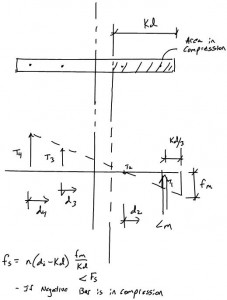Design of Masonry Shear Walls – ASD
There are a few methods that we can use to design masonry shear walls, see here for another ‘simplified’ method. Here we will present a method based on force equilibrium and an adjusted bar spacing. Also included is an example and a spreadsheet. This method is a bit more involved than the simplified method but we can better analyse the shear wall and provide an economic design. We will distribute the tension due to bending stress to steel reinforcement based on a linear strain distribution. Steel in compression will be neglected (it must be tied to be considered effective in compression) per MSJC (for lateral tie requirements refer to Ref 1 Section 2.1.6.5) . Note that this procedure assumes that there is net tension on the section. If there is no net tension than only jamb steel is needed and axial needs to be checked. If you iterate the section and Kd is greater than the length of wall then the entire section is in compression and there is no net tension.
References:
Ref 1. MSJC 2005 and 2008 Building Code Requirements and Specification for Masonry Structures and Related Commentaries (AKA TMS 402 or ACI 530). Found here
Ref 2. Masonry Structures Design and Behavior, Second Edition by Drysdale, Hamid and Baker (the Third edition found here)
Ref 3. Reinforced Masonry Engineering Handbook 6th Edition by Max Porter. Found here
Notes/Examples:
Reinforced Masonry Shear Wall – Force Equilibrium Adjusted Spacing Notes
Masonry Shear Wall Design ASD – Force Equilibrium Example
Shear Wall ASD – Force Equilibrium Adjusted Spacing Spreadsheet
Procedure:
- Calculate Section Properties.
- Calculate out-of-plane or weak axis section properties based on the bar spacing and grout. Then divide these properties by the bar spacing so that they you have Area/ft of wall, I (moment of inertia)/ft of wall and then r (radius of gyration).
- Adjust Bar Spacing
- Because we normally specify the on center spacing of the bars, find the number of bars based spacing and wall length N’ = L/S + 1 and round down. This will be 1 bar less than placed in the field. Find the adjusted spacing S’ = L’ / (N’-1). We will assume bars will be placed in the first cell and then placed at the on center spacing. Use this spacing/layout in the analysis.
- Wall Analysis – Combined Axial and Moment Forces
- First find the eccentricity of the required load er=Mr/Pr. Then to maintain equilibrium the ratio of the section must have the same eccentricity ed=Mn/Pn. We assume a triangular compressive stress distribution and only the reinforcement resists tension.
- Start by assuming the location of the neutral axis (NA) from the end of the wall this distance is Kd.
- Assuming that there is net tension in the section, find the compressive force in the masonry, Cm = 0.5*A/ft * Kd (based on triangular stress distribution).
- Find the tension force in each rebar. Based on a linear strain distribution the the stress can be found as fs=n(di-Kd)*fm/Kd. Where n=modular ratio (Es/Em), di=distance from extreme compression face to the rebar under consideration. This stress should be less than the allowable stress (minimum (24ksi, Fy/2.4)). However it should not carry any compression stress unless ties are provided.
- Find the compressive strength of the section. Pn=Cm-Ttotal.
- Find the moment strength of the section. Mn=Mcm+Mtot
- Where Mcm is the masonry compression x moment arm (L/2-Kd/3) and Mtot = Ti (tension force of rebar) x moment arm (di-L/2).
- Find ed = Mn/Pn. Iterate Kd if this does not match er.
- Shear Design
- See here for shear design
- Axial check for slenderness.
- See here for axial design. The area used in this check should be the total net area of the wall (not kd) but area should be subtracted out for partial grout.
- Perform Checks
-
- Check that the section axial load strength is greater than the required, Pn=Pc > Pr
- Check that the section moment strength is greater than the required, Mn=Mc > Mr
- Check axial – slenderness. Check Pcs > Pr the area used
